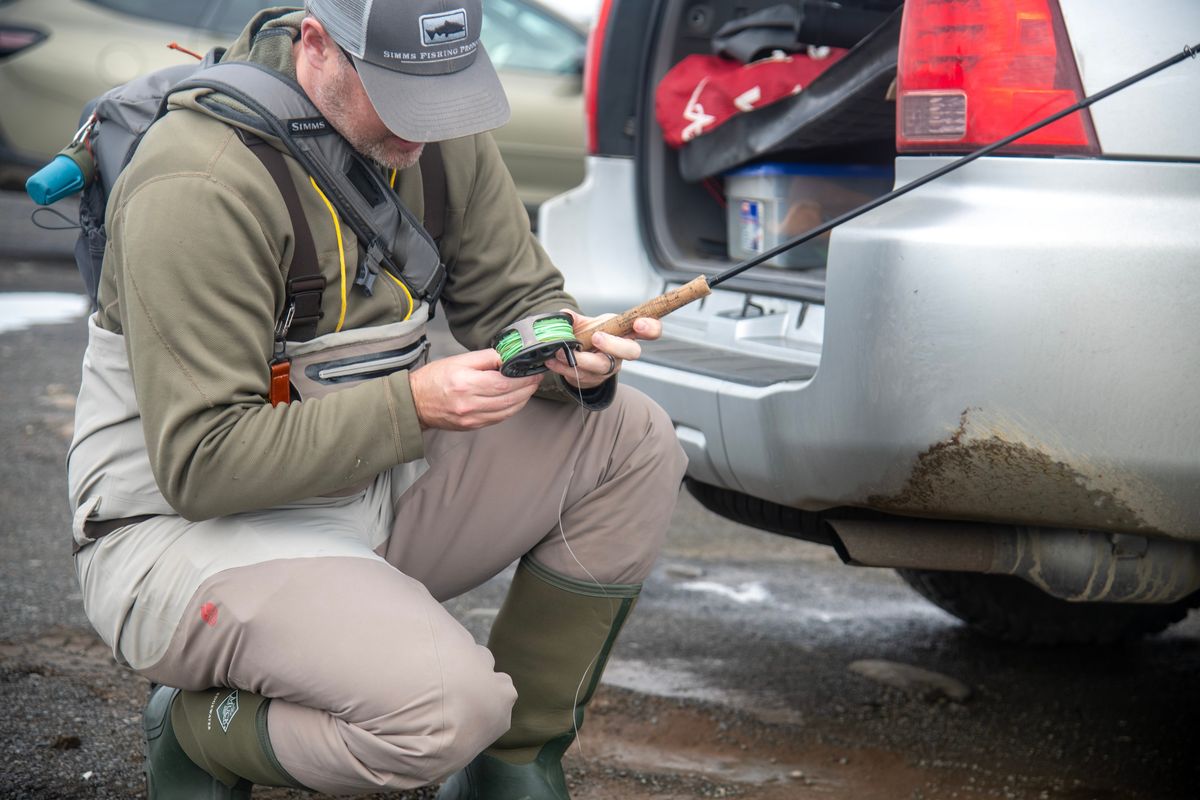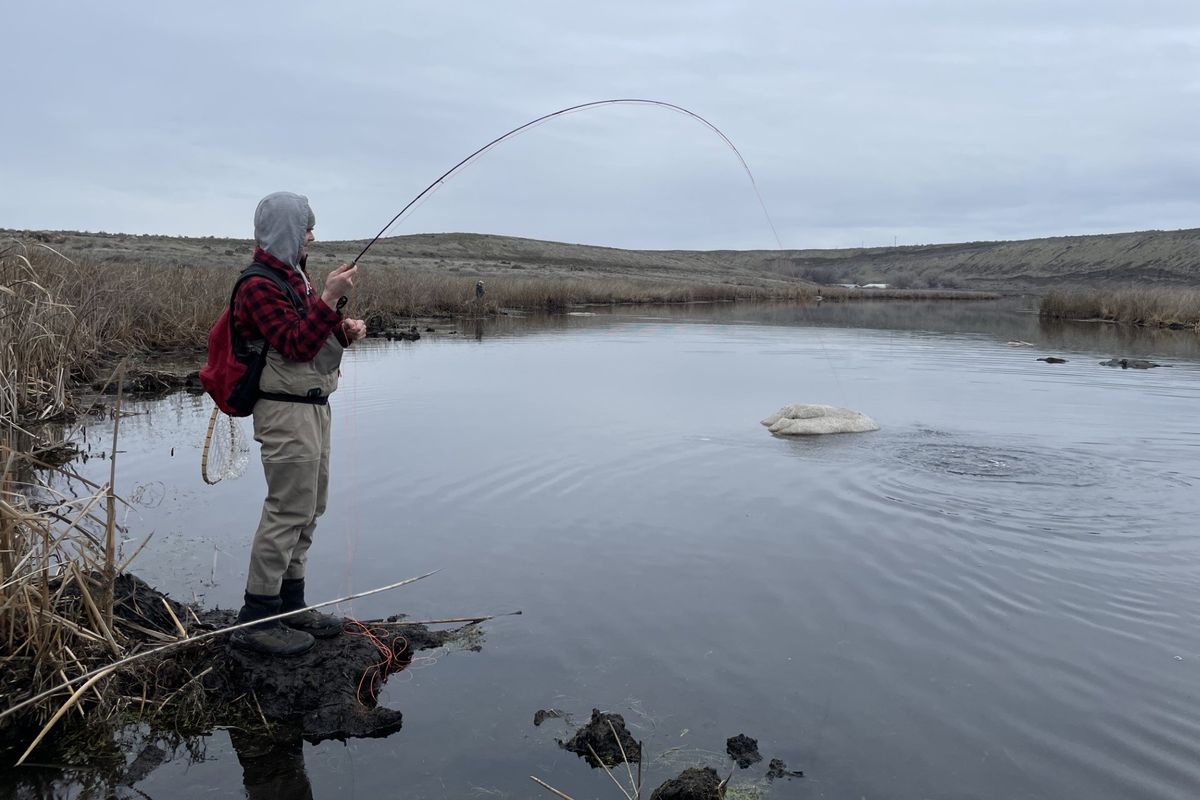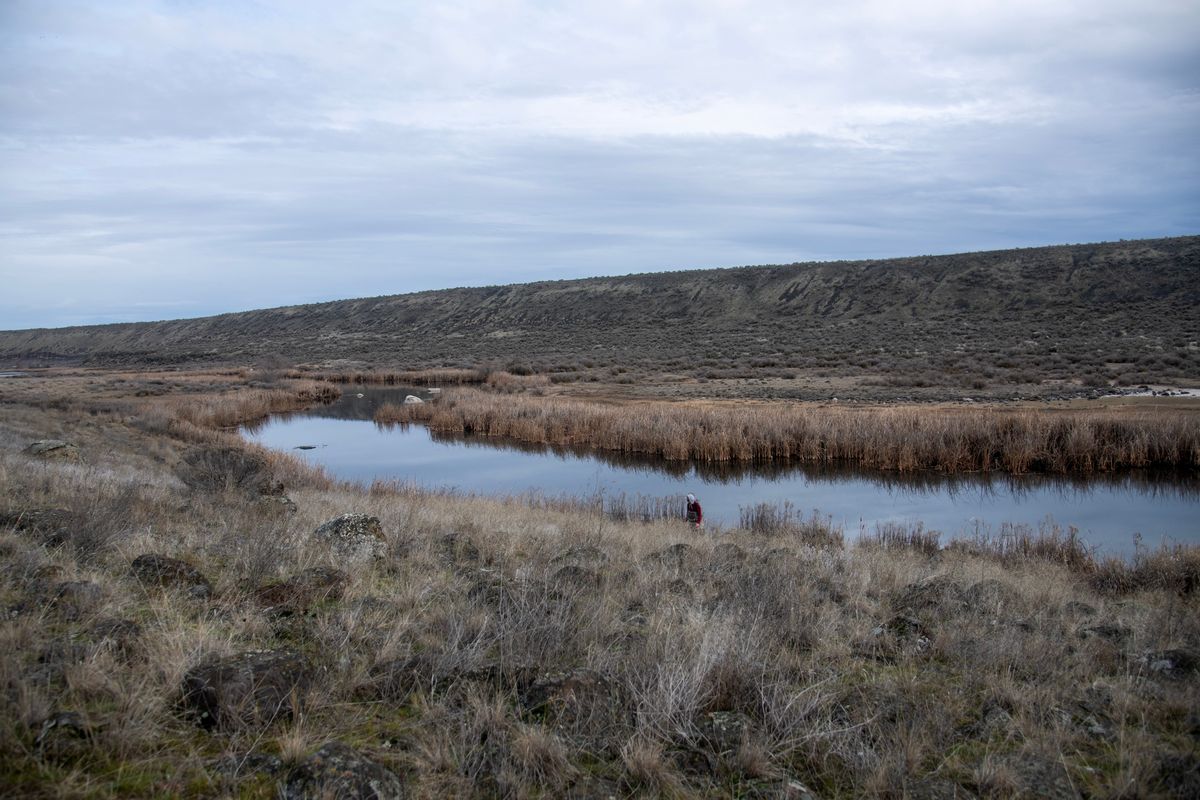Big fish, a broken rod and jealousy at Rocky Ford Creek
This secytion of Rocky Ford Creek in Eastern Washington draws fisherman for hatchery fish planted by Troutlodge hatchery Thursday, Feb. 2, 2024. Fishermen were looking for large planted rainbow trout. (Michael Wright/THE SPOKESMAN-REVIEW)
EPHRATA – As the sun faded, my desperation grew. I’d spent most of a day trying to convince the fat rainbow trout of Rocky Ford Creek to eat something. Scuds and mayfly nymphs were ignored. So were olive wooly buggers.
It was time to change flies – again – so I reeled up and sat down, wondering if there was any magic in my fly box. Just then, Joe Zimbric hooked his fourth fish of the day. Everything he tried seemed to work.
Most of the fish in Rocky Ford Creek are big, and he later said he thought this was the biggest he’d seen that day. It ran and he pulled, and then it ran again. His four-weight rod bent deeply, forming a neat arc above his head.
When he thought he’d sufficiently worn it out, he brought the fish close and reached with his net.
A few seconds later, Joe was holding three-quarters of a fly rod, and the fish was gone. Fish No. 4 had snapped his four-weight.
Desert trout
Rocky Ford Creek bubbles out of the ground in the desert north of Moses Lake and turns into a wide, slow creek, with long pools and a few riffles.
It’s a catch-and-release, fly-fishing only stream with no wading. It’s full of stocked fish from the Troutlodge Hatchery, which sits on its banks. The hatchery sits on state land, and it pays its rent in fish, said Mike Schmuck, a biologist for the Washington Department of Fish and Wildlife.
Hatchery managers release broodstock rainbow trout into the stream – adult fish used to breed and produce more fish, all of them big. The ones who live through the summer and evade the resident pelicans grow even larger. Rocky Ford devotees occasionally tell stories of 10 pound bruisers.
It’s a strange fly-fishing oasis in the scablands. Some anglers don’t get the allure. They see it as something like an adult fish pond – an unnatural amusement park engineered to satisfy the most desperate of fish cravings.
For others, it presents an irresistible challenge. A place to chase big, smart fish in slow water. A place where small mistakes can be the difference between a skunking and the lunker of a lifetime.
And, because it always runs clear and never freezes, the creek provides a reason to dust off the fly rod during the cold months.
“The most popular time for the creek is definitely wintertime,” said Darc Knobel, owner of the Desert Fly Angler in Ephrata.
Stalking the banks
Earlier this month, Joe and I decided to make the trek to the creek. We left Spokane early, hoping to get on the water before noon. We made it, but we were far from the first to arrive.
Nearly all of the fishing on Rocky Ford happens on a short stretch between Troutlodge hatchery’s two facilities. It’s on public land, so the shoreline is easy to walk, and a dirt road parallels the creek.
When Joe an I got there, there were a few cars in each of the three parking lots. Once we got down to the water, though, there was plenty of elbow room. A few anglers were clumped around a walking bridge there, but plenty of shoreline remained unoccupied.
The trip was a first for both of us. I’d driven to the creek to look around once before, but hadn’t been back since. Winter’s junior varsity performance to that point made a trip even more enticing, and a forecast calling for cloud cover and temperatures in the mid-to-high 40s had me dreaming of a mayfly hatch.
That dream never materialized. Fish occasionally rose, but not with any consistency. So we stuck to the subsurface program common here – leeches, scuds, small nymphs.
About an hour in, Joe had his first fish on. When it broke the surface and splashed, it sounded like someone had thrown an encyclopedia into the water. It was well over 20 inches, and fat.
We kept moving, covering as much water as possible. I flailed and Joe hooked a couple more fish. After an afternoon rainstorm chased away most of the other anglers, we crossed the footbridge and made our way to a short piece of water with boulders and a decent current. It was the best looking part of the stream, with obvious holding water.
When we got there, we saw the rainbows hugging the bottom. Casting to fish you can see is a recipe for disappointment. I did it anyway. Every time the fly came close to one of them, the fish either stayed completely still or smugly moved aside. They were not fooled.
Meanwhile, Joe tied on a hare’s ear nymph and dropped it into a riffle about 50 yards upstream of me. That’s when he hooked the rod breaker. The fish made a hard run as he reached for it, and the rod’s tip section couldn’t handle it.
At the time, part of me wanted to chalk it up to karma. That’s what you get for hogging all the action. But later, as we dissected the tragedy, I realized how impressive it actually was.
Fly rods are not indestructible, but their fragility is usually exposed by errant footsteps or the careless use of a car door. That was the first time I’ve seen one get broken by a fish.
I just wish it was mine.






